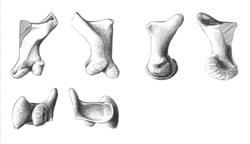Rapator
| Rapator Temporal range: Early Cretaceous, 105Ma | |
|---|---|
 | |
| Illustration of the holotype manual bone | |
| Scientific classification | |
| Kingdom: | Animalia |
| Phylum: | Chordata |
| Clade: | Dinosauria |
| Suborder: | Theropoda |
| Clade: | †Megaraptora |
| Genus: | †Rapator Huene, 1932 |
| Type species | |
| †Rapator ornitholestoides Huene, 1932 | |
Rapator is a genus of carnosaurian dinosaurs from the Griman Creek Formation of New South Wales, Australia, dating to the Albian age of the early Cretaceous period, 105 million years ago.[1] It contains only the type species, Rapator ornitholestoides, which was originally named by Friedrich von Huene in 1932.[2]
Description
The holotype and only known specimen, BMNH R3718, consists of a single left hand bone, discovered around 1905 near Wollaston, on the Lightning Ridge.[3] The fossil has been opalised.[3] The bone has a length of seven centimetres.[2] This manual element shows a prominent dorsomedial process, a feature shared with the much smaller Ornitholestes which occasioned the specific name.[3] The process with Ornitholestes is much less distinctive though.[3] On its upper end there is only one cotyle, from which von Huene deduced it must have been a metacarpal.[2] However, several coelurosaurian groups lack a second cotyle on the first phalanx also. If Rapator had a build like Australovenator, it would have attained a considerable size: a body length of nine metres (30 ft) has been estimated.[3]
Classification
The type specimen of Rapator was originally described as a metacarpal I, a bone from the upper part of a theropod's hand.[2] It was later noted that the bone is similar to a finger bone, the first phalanx of the first finger, of an alvarezsaur[4] or of a primitive coelurosaurian similar to Nqwebasaurus.[5] With the discovery of Australovenator, which had a similar metacarpal, Rapator was recognized as a probable megaraptoran. In fact, Australovenator and Rapator differ only in some small details of the bone and may be synonyms, though Agnolin and colleagues in 2010 considered Rapator a dubious genus (nomen dubium) due to its fragmentary nature.[6] However, White et al. found differences between the hand bone of Rapator and the equivalent bone of Australovenator, supporting the distinction between the two. They also noted that the two genera come from formations separated chronologically by about 10 million years, making them unlikely to be synonymous.[1]
Rapator has been synonymised with Walgettosuchus, a theropod found in the same formation.[7] As the latter is only known from a caudal vertebra, the identity cannot be proven.
Etymology
The meaning of the generic name is problematic. Von Huene gave no etymology.[2] "Rapator" does not exist in Classical Latin and occurs only very rarely in Mediaeval Latin with the meaning "violator".[8] One possible explanation is that von Huene, having been influenced by Latin raptare, "to plunder",[9] mistakenly thought such a word actually existed with the meaning of "plunderer".[10] It has also been considered a simple misspelling of, or confusion with, raptor, "seizer" or "thief".[3] The specific name means "resembling Ornitholestes".
References
- ↑ 1.0 1.1 White, M. A.; Falkingham, P. L.; Cook, A. G.; Hocknull, S. A.; Elliott, D. A. (2013). "Morphological comparisons of metacarpal I forAustralovenator wintonensisandRapator ornitholestoides: Implications for their taxonomic relationships". Alcheringa: an Australasian Journal of Palaeontology: 1. doi:10.1080/03115518.2013.770221.
- ↑ 2.0 2.1 2.2 2.3 2.4 Huene, F. von. (1932). Die fossile Reptil-Ordnung Saurischia, ihre Entwicklung und Geschichte. Monogr. Geol. Pal. 4 (1) pts. 1 and 2, viii + 361 pp.
- ↑ 3.0 3.1 3.2 3.3 3.4 3.5 Long, J.A. (1998). Dinosaurs of Australia and New Zealand and Other Animals of the Mesozoic Era, Harvard University Press, p. 104
- ↑ Holtz, Molnar, and Currie (2004). "Basal Tetanurae." In Weishampel, Dodson and Osmolska (eds.), The Dinosauria Second Edition. University of California Press. 861 pp.
- ↑ Salisbury, Agnolin, Ezcurra, and Pias (2007). "A critical reassessment of the Cretaceous non-avian dinosaur faunas of Australia and New Zealand." Journal of Vertebrate Paleontology, 27(3): 138A.
- ↑ Agnolin, Ezcurra, Pais and Salisbury, (2010). "A reappraisal of the Cretaceous non-avian dinosaur faunas from Australia and New Zealand: Evidence for their Gondwanan affinities." Journal of Systematic Palaeontology, 8(2): 257-300.
- ↑ Steel, R. (1970) Handbuch der Paläoherpetologie/Encyclopedia of Paleoherpetology. Part 14. Saurischia. Gustav Fischer Verlag, Stuttgart 1-87
- ↑ Tombeur, Paul. (1998) Thesaurus formarum totius Latinitatis a Plauto usque ad saeculum XXum : TF. CETEDOC, Universitas Catholica Lovaniensis, Lovanii Novi
- ↑ http://web.archive.org/web/20100920040121/http://dinosauria.com/dml/names/dinor.htm Dinosauria Translation and Pronunciation Guide, retrieved 28-09-2010
- ↑ Lambert, D. (1991) The Dinosaur Data Book: the definitive illustrated encyclopedia of dinosaurs and other prehistoric reptiles. Gramercy Books. p. 89